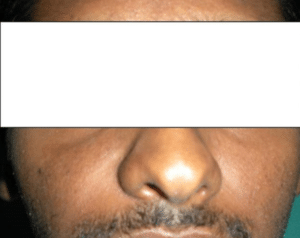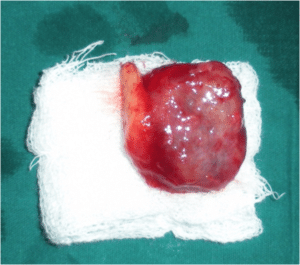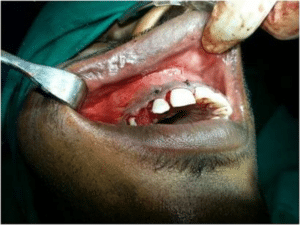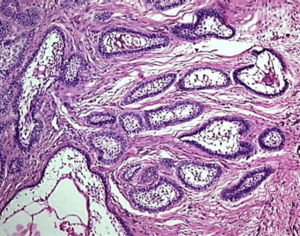Divakar Thiruvenkata Krishnan1*, I Packiaraj2
1Associate Professor, Department of Oral and Maxillofacial Surgery, Rajas Dental College and Hospital, Tirunelveli, Tamil Nadu, India
2Professor and HOD, Department of Oral and Maxillofacial Surgery, Rajas dental College and Hospital, Tirunelveli, Tamil Nadu, India
Correspondence author: Divakar Thiruvenkata Krishnan, Associate Professor, Department of Oral and Maxillofacial Surgery, Rajas Dental College and Hospital, Tirunelveli, Tamil Nadu, India; E-mail: [email protected]
Published Date: 02-01-2024
Copyright© 2024 by Krishnan DT, et al. All rights reserved. This is an open access article distributed under the terms of the Creative Commons Attribution License, which permits unrestricted use, distribution, and reproduction in any medium, provided the original author and source are credited.
Abstract
An Adenomatoid Odontogenic Tumor (AOT) isa hamartomatous lesion rather than truly neoplastic and one among the rare tumors of the oral cavity. The adenomatoid odontogenic tumor is treated by surgical enucleation along with the involved tooth. This tumor has the least chance for recurrence and hence it does not require radical excision. The adenomatoid odontogenic tumor is more common in females than males. This paper was a case report on the follicular variant of AOT of anterior maxilla associated with impacted canine and its surgical enucleation in a young male patient.
Keywords: Adenomatoid Odontogenic Tumor; Recurrence; Anterior Maxilla; Enucleation; Follicular
Introduction
An Adenomatoid Odontogenic Tumor (AOT) commonly called as the two-third tumor is one of the uncommon tumors of the oral cavity which represents around 3% of the odontogenic tumors [1]. The most common site of occurrence is the anterior maxilla with more predilection towards the female in the second decade of life [2,3]. Because of the less aggressive nature of the tumor and the least chance of recurrence the surgical enucleation remains the mainstay of the treatment.
AOT is a non-aggressive epithelial odontogenic tumor that occurs in forms of intraosseous and peripheral forms. The intraosseous variants are the most frequent and include follicular and extrafollicular types. Radiographically, the follicular intraosseous lesions appear as a unilocular radiolucent area, with well-defined borders and most commonly related with an impacted tooth. Two -thirds of intraosseous cases present with radio-opacity within them [4]. Surgical management is most commonly recommended with enucleation of the lesion and removal of the impacted teeth. But in some cases, orthodontic repositioning of the teeth can also be done considering the less aggressive nature of the tumor and the least chance of recurrence [5].
Case Report
A 20-year-old male patient reported to the clinic with the complaint of swelling on the right side of the face for the past 6 months. The swelling is progressively increasing in size with symptoms of pain intermittently. There is no history of paraesthesia in the right side of the face.
Extraoral examination reveals there is a swelling in the right side of the face measuring 3×4 cm in size extending from the lateral side of the ala of the nose obliterating the nasolabial fold (Fig. 1).

Figure 1: Extraoral view showing obliteration of nasolabial fold on right side.
No paraesthesia elicited on two-point discrimination test. Intra oral examination reveals there is swelling measuring 3×3 cm in size extending from the lateral incisor to the first premolar obliterating the vestibular space. There is a retained deciduous canine (53) in right side of maxilla (Fig. 2).

Figure 2: Intra oral view showing obliteration of buccal vestibule from 12 to 14.
Radiographic examination reveals a unilocular radiolucent area extending from the central incisor to first premolar measuring 4×4 cm in size with radio-opaque mass present in the upper part of lesion suggesting the presence of impacted canine (Fig. 3).

Figure 3: OPG showing radiolucency from 12 to 15 with impacted 13.
Considering all the factors the initial diagnosis has been made as benign odontogenic lesion and the surgical plan has been formulated to enucleate the lesion along with impacted canine (13) and extraction of retained deciduous tooth (53). Under GA through nasotracheal intubation, the crevicular incision has been made from 21 to 16. The full-thickness mucoperiosteal flap raised and the surgical removal of the lesion has been done (Fig. 4). The lesion has been excised in toto along with the impacted teeth (Fig. 5). Then the sharp margins of the bone were smoothened and closure was done with 3-0 vicryl (Fig. 6).

Figure 4: Surgical enucleation of the lesion with impacted 13.

Figure 5: Excised specimen with impacted teeth.

Figure 6: Closure done with 3-0 vicryl.
The excised lesion was sent for biopsy and the report confirmed the diagnosis of Adenomatoid odontogenic tumor of the follicular variant. Microscopically the H &E stained soft tissue section shows several duct-like structures resembling proliferating odontogenic epithelium composed of polarized tall columnar cells and spindle cells occupying the central space. The fibrovascular connective tissue stroma shows moderate inflammatory cell infiltrate suggestive of the follicular type of Adenomatoid odontogenic tumor (Fig. 7).

Figure 7: Microscopic picture of excised lesion.
Discussion
AOT is relatively an uncommon tumor of the oral cavity which contributes about 2-7% of the odontogenic epithelial tumors. This tumor is more predominant among young female individuals in the second decade of life [5]. The most common site of occurrence is the anterior maxilla as reported in this case [2,3]. Radiographs usually show a well-defined radiolucency but, in some cases, calcifications within the tumor can produce faint radio-opacities. Histopathologically, many AOT demonstrates small calcifications associated with the proliferative epithelial elements and these may appear on a radiograph as small ‘snowflake’ calcifications present in the radiolucent area. But the case represented here has no such radio-opacities. The lesion is often associated with an unerupted tooth and may misinterpret as a dentigerous cyst. The case represented here also has an impacted canine tooth associated with the lesion. AOT is a slow-growing lesion that is asymptomatic but capable of producing buccal cortical expansion with displaced of adjacent teeth as in the case reported here.
There are two major variants of AOT central (intraosseous) and peripheral [4]. The intraosseous variant may be follicular which is most commonly associated with the unerupted teeth and extrafollicular not associated with teeth but most commonly found between the roots of the teeth [6]. The peripheral type is found in gingival mucosa. The case presented here is an intraosseous follicular variant that has an almost null chance of recurrence after surgical enucleation. The enucleation of the tumor along with the impacted or submerged teeth remains the mainstay of treatment as there is the least chance of recurrence [7,8]. The preservation of teeth and then the further orthodontic movement of teeth also have been evidenced in literature with good prognosis [5]. Surgical excision is the treatment of choice in most of adenomatoid odontogenic tumor as the chances of recurrence is very least and the prognosis after excision is excellent [7,9]. Follow-up of 24 months in our case after surgery shows no recurrence.
Conclusion
Adenomatoid odontogenic tumors are asymptomatic, encapsulated lesions with rare occurrence can be well treated by enucleation of the lesion along with the removal of the involved tooth. There is very little chance of recurrence for this tumor because of the encapsulated nature of this tumor. In the case reported here, the AOT with right upper maxillary canine has been enucleated along with impacted canine shows a good prognosis with no recurrence. Early diagnosis and prompt treatment of this lesion by a surgeon will prevent extensive damage to the bone and other associated structures.
Conflict of Interest
The authors have no conflict of interest to declare.
References
- Batra P, Prasad S, Parkash H. Adenomatoid odontogenic tumour: review and case report. J Can Dent Assoc. 2005;2013:250-3.
- Seo WG, Kim CH, Park HS, Jang JW, Chung WY. Adenomatoid odontogenic tumor associated with an unerupted mandibular lateral incisor: a case report. J Korean Assoc Oral Maxillofac Surg. 2015;41:342-5.
- Philipsen HP, Reichart PA, Siar CH, Ng KH, Lau SH, Zhang X, et al. An updated clinical and epidemiological profile of the adenomatoid odontogenic tumour: a collaborative. J Oral Pathol Med. 2007;36(7):383-93.
- Narayanan VS, Naidu G, Ragavendra R, Mhaske-Jedhe S, Haldar M. Adenomatoid odontogenic tumor of the mandible with unusual radiographic features: A case report. Imaging Sci Dent. 2013;43:111-5.
- Motamedi MH, Shafeie HA, Azizi T. Salvage of an impacted canine associated with an adenomaoid odontogenic tumour: a case report. Br Dent J. 2005;199:89-90.
- Philipsen HP, Birn H. The adenomatoid odontogenic tumor: Ameloblastic adenomatoid tumor or adeno‑ ameloblastoma. Acta Pathol Microbiol Scand. 1969;75:375‑98.
- Philipsen HP, Srisuwan T, Reichart PA. Adenomatoid odontogenic tumor mimicking a periapical (radicular) cyst: a case report. Oral Surgery, Oral Medicine, Oral Pathology, Oral Radiology, and Endodontol. 2002;94(2):246-8.
- Mohamed A, Singh AS, Raubenheimer EJ, Bouckaert MM. Adenomatoid odontogenic tumour: review of the literature and an analysis of 33 cases from South Africa. Int J Oral Maxillofacial Surg. 2010;39(9):843-6.
- Marx RE, Stern D. Oral and maxillofacial pathology: a rationale for diagnosis and treatment. Hanover Park: Quintessence Publishing Company. 2012.
Article Type
Case Report
Publication History
Received Date: 27-11-2023
Accepted Date: 26-12-2023
Published Date: 02-01-2024
Copyright© 2024 by Krishnan DT, et al. All rights reserved. This is an open access article distributed under the terms of the Creative Commons Attribution License, which permits unrestricted use, distribution, and reproduction in any medium, provided the original author and source are credited.
Citation: Krishnan DT, et al. Adenomatoid Odontogenic Tumour of Maxilla: A Case Report. J Dental Health Oral Res. 2024;5(1):1-6.

Figure 1: Extraoral view showing obliteration of nasolabial fold on right side.

Figure 2: Intra oral view showing obliteration of buccal vestibule from 12 to 14.

Figure 3: OPG showing radiolucency from 12 to 15 with impacted 13.

Figure 4: Surgical enucleation of the lesion with impacted 13.

Figure 5: Excised specimen with impacted teeth.

Figure 6: Closure done with 3-0 vicryl.

Figure 7: Microscopic picture of excised lesion.


